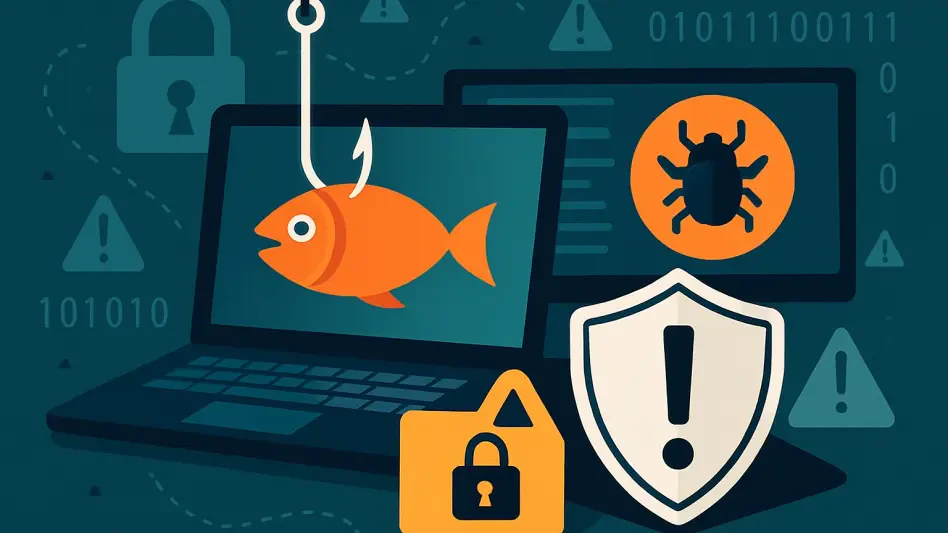In an era where digital threats loom larger than ever, law firms have become prime targets for cybercriminals seeking to exploit sensitive client information, regardless of their size. These firms hold a treasure trove of data, including confidential client communications, financial records, and strategic legal documents, making them irresistible to malicious actors. The stakes are incredibly high as attackers leverage vulnerabilities such as weak passwords, outdated technology, and insufficient staff training to gain unauthorized access. This growing menace not only jeopardizes client trust but also poses significant financial and reputational risks to the legal industry. As cyberattacks become more sophisticated, understanding the specific challenges faced by law firms is crucial. The urgency to strengthen defenses against these digital predators cannot be overstated, prompting a closer examination of how prepared the sector is to combat such threats and what steps can be taken to safeguard invaluable data from falling into the wrong hands.
1. Assessing Cybersecurity Preparedness in Law Firms
Law firms can be categorized into three distinct groups based on their approach to cybersecurity, each with varying levels of readiness to counter digital threats. The first group consists of proactive firms that identify vulnerabilities and implement solutions swiftly, ensuring robust protection of client data. These firms prioritize security as a core component of their operations, often dedicating resources to specialized IT teams. In contrast, the second group recognizes potential issues but fails to act, leaving gaps that cybercriminals can exploit. This hesitation often stems from budget constraints or a lack of urgency. The third group, frequently comprising smaller firms, remains entirely unaware of their vulnerabilities. Without dedicated IT or security personnel, their data is at heightened risk, making them easy targets for attacks. This disparity in preparedness underscores the need for tailored strategies to address the unique challenges faced by firms of different sizes and capabilities.
Even larger law firms are not immune to these risks, especially when cybersecurity is not a standalone priority. In many cases, it is bundled into general IT responsibilities, allowing threats to slip through unnoticed. IT departments in such firms are often more focused on integrating emerging technologies like artificial intelligence to drive innovation, rather than fortifying defenses. This misalignment can create blind spots, as firm administrators may assume cybersecurity is the primary focus of IT teams. The reality, however, reveals a gap in attention that attackers are quick to exploit. Addressing this issue requires a cultural shift within the industry, where cybersecurity is elevated to a critical function, separate from other technological advancements, ensuring that protecting client information remains paramount in an increasingly digital legal landscape.
2. Meeting Client Expectations for Data Protection
Clients today place immense value on the security of their sensitive information, expecting law firms to uphold the highest standards of data protection. This expectation is not merely a preference but a demand, as many are willing to invest more in firms that can demonstrate robust cybersecurity measures. Trust forms the bedrock of the attorney-client relationship, and any breach can irreparably damage that bond, leading to loss of business and potential legal repercussions. Firms that fail to prioritize security risk alienating clients who are increasingly aware of digital threats and seek assurance that their confidential matters are safe from prying eyes. This growing awareness among clients serves as a wake-up call for the legal sector to reassess and reinforce their cybersecurity frameworks to meet these non-negotiable expectations.
Beyond trust, the financial implications of inadequate security are significant for law firms. Clients are not only looking for expertise in legal matters but also for partners who can guarantee the safety of their data in a world rife with cyber threats. Firms that invest in advanced security protocols and transparent communication about their protective measures can differentiate themselves in a competitive market. This investment is often seen as a worthwhile expense, as it builds client confidence and loyalty over the long term. Additionally, showcasing a commitment to cybersecurity can serve as a marketing advantage, attracting high-profile clients who prioritize data protection. As the legal industry evolves, aligning with client expectations on security will become a defining factor in a firm’s success and reputation.
3. Identifying Common Vulnerabilities in Legal Practices
Law firms face a multitude of vulnerabilities that cybercriminals exploit with alarming regularity, starting with insecure passwords and access controls. The use of shared accounts, simplistic passwords, and the absence of two-factor authentication (2FA) creates easy entry points for unauthorized access. Additionally, outdated software and hardware pose significant risks, as unpatched systems contain known flaws that attackers target. Surprisingly, even overlooked devices like printers can serve as gateways for breaches if not secured properly. These basic lapses in security infrastructure highlight a critical need for firms to overhaul their access and update protocols to prevent attackers from gaining a foothold in their networks, thereby protecting sensitive client information from exposure.
Further compounding the issue are poor data storage practices and a lack of cybersecurity awareness among staff. Storing sensitive client information on unsecured devices, shared folders, or unprotected cloud platforms invites disaster. Employees, often unaware of potential threats, become the weakest link, falling prey to phishing and social engineering tactics designed to extract confidential data. Moreover, third-party vendors introduce additional risks, as weaknesses in external platforms or unsafe user behaviors can lead to breaches that compromise data shared with clients or courts. These multifaceted vulnerabilities necessitate a comprehensive approach to security, addressing not just technology but also human factors and external partnerships to create a fortified defense against cyber threats.
4. Rising Tide of Cyberattacks on Legal Entities
The frequency and severity of cyberattacks on law firms have surged, with alarming statistics painting a grim picture of the current landscape. According to Proton, 20% of law firms encountered a cyberattack in the past year, and of those, 39% resulted in data loss or exposure. A notable case involved Orrick, Herrington & Sutcliffe, which settled a class action lawsuit for $8 million in 2024 following a 2023 breach that exposed personal details of over 600,000 individuals. Additionally, the FBI has issued warnings about the Silent Ransom Group, active since 2022, which steals client data and demands payment under threat of leakage. Recently, this group has shifted tactics to vishing, impersonating IT staff to trick employees into installing remote access tools, demonstrating the evolving sophistication of these threats.
The global impact of such attacks is evident in incidents like the data breach at the UK’s Legal Aid Agency, which exposed sensitive case information and disrupted digital services, including payments and case processing. Beyond criminal groups, nation-state actors are increasingly targeting law firms for espionage, valuing the strategic importance of client and corporate data. These attacks, linked to foreign governments, elevate the stakes, as compromised information can have far-reaching geopolitical consequences. The legal sector must recognize the diverse nature of these threats, from financially motivated ransomware to state-sponsored espionage, and adapt defenses accordingly to mitigate risks and protect their critical assets from an array of adversaries.
5. AI’s Dual Role in Transforming Threats and Solutions
Artificial intelligence has emerged as a powerful tool for law firms, streamlining operations through applications in document management, legal research, contract review, and risk assessment. By automating repetitive tasks and enhancing efficiency, AI allows legal professionals to focus on higher-value work, improving client service and operational outcomes. However, while AI offers undeniable benefits, it also introduces new vulnerabilities that cybercriminals are quick to exploit. The integration of such technology must be accompanied by stringent security measures to ensure that the advantages do not come at the cost of exposing sensitive data to innovative forms of attack that leverage the same cutting-edge tools for malicious purposes.
On the flip side, AI is reshaping the threat landscape by enabling highly sophisticated attacks that challenge even seasoned professionals. Advanced phishing schemes and deepfake videos or calls can deceive clients, courts, or lawyers by fabricating evidence or communications with startling realism. According to ISACA, 71% of IT and cybersecurity experts anticipate an increase in the quality and prevalence of deepfake threats in the coming year. The accessibility and affordability of these tools amplify the danger, making it imperative for law firms to stay ahead of emerging risks. Balancing the adoption of AI for operational gains with robust countermeasures against its misuse is a critical challenge that the legal sector must navigate to safeguard client trust and data integrity.
6. Implementing Protective Measures for Data Security
To combat the escalating cyber threats, law firms must adopt a multi-layered approach to security, starting with a comprehensive incident response plan. This plan should outline steps for detection, containment, communication, and recovery, with clear roles assigned to IT, legal, and operations teams. Regular simulations to test the plan’s effectiveness are essential, as is updating it to address new threats. Additionally, employee training on recognizing phishing, business email compromise (BEC), and social engineering tactics is crucial. Hands-on exercises and performance monitoring can help identify gaps in awareness. Strengthening password policies with unique, complex passwords and multi-factor authentication (MFA) across key systems like email and cloud storage further fortifies defenses against unauthorized access.
Beyond these steps, law firms should prioritize data backup and recovery by automating backups for critical systems and storing them in encrypted, separate locations. Testing recovery processes under realistic conditions ensures reliability. Encrypting data at rest and in transit, while regularly reviewing protocols to meet current standards, adds another layer of protection. Patch management and system monitoring are equally vital, with centralized logging and security information and event management (SIEM) tools detecting suspicious activity early. Finally, implementing role-based access control (RBAC) limits access to necessary data based on job roles, while auditing accounts prevents misuse. These combined efforts create a resilient security posture, safeguarding client information against the relentless wave of cyber threats.
7. Fortifying the Future of Legal Data Protection
Looking back, the legal industry grappled with an unprecedented surge in cyberattacks that exposed critical vulnerabilities in data protection practices. High-profile breaches and sophisticated threats, amplified by technologies like AI, underscored the urgent need for robust defenses. Law firms, both large and small, faced the harsh reality that no entity was immune to the cunning tactics of cybercriminals, from ransomware groups to nation-state actors. The financial and reputational damages suffered served as stark reminders of the consequences of inadequate security, pushing the sector to rethink its approach to safeguarding sensitive client information.
Moving forward, the path to resilience lies in proactive investment in comprehensive cybersecurity strategies. Law firms must commit to regular audits of their systems, prioritize ongoing staff education, and embrace advanced technologies for threat detection and prevention. Collaboration with cybersecurity experts to tailor solutions to specific risks can provide a competitive edge. Additionally, fostering a culture of security awareness at every level of the organization ensures that protecting client data remains a shared responsibility. By taking these decisive steps, the legal sector can build a fortified future, ready to withstand the evolving challenges of the digital age.








